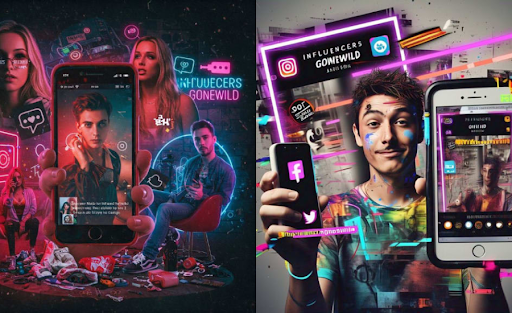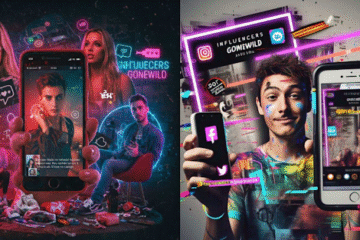In the digital era, the concept of influence has shifted from traditional celebrity power to internet-based popularity. Social media influencers have emerged as trendsetters, tastemakers, and in some cases, full-blown internet celebrities. But with this rise in visibility and reach has also come a growing concern: are influencers pushing the boundaries too far just to stay relevant?
The emergence of platforms and pages like Influencersgonewild has brought this debate to the forefront. A space once associated with light-hearted content, entertainment, and viral trends now increasingly features hyper-personal content, provocative performances, and unfiltered expressions of fame. It raises an essential question—how much is too much?
In this article, we explore the truth behind the growing phenomenon of digital overexposure, the role of platforms like Influencersgonewild, and the deeper impact on both creators and consumers.
The Rise of the Influencer Economy
Influencer culture didn’t emerge overnight. It began with relatable, everyday individuals sharing tips, reviews, or personal stories on platforms like YouTube, Instagram, and TikTok. As their follower counts rose, so did their value to brands, turning content creation into a full-time career.
At first, it was about lifestyle vlogs, travel diaries, food reviews, and daily routines. But as the competition intensified and algorithms started rewarding extreme engagement, many influencers found themselves needing to post more provocative, dramatic, or controversial content to stay visible.
Platforms like Influencersgonewild have capitalized on this shift, curating and redistributing moments where influencers step outside the typical norms—sometimes humorous, other times shockingly explicit.
What Exactly Is Influencersgonewild?
Influencersgonewild is one of several online platforms that showcase viral moments of influencers caught in candid, unexpected, or highly personal situations. While some of the content is light and humorous, others venture into highly revealing and unfiltered territory. From wardrobe malfunctions to suggestive dances, from private rants to overly revealing content, the platform walks a thin line between entertainment and exploitation.
For some viewers, it’s pure curiosity. For others, it’s a guilty pleasure. But for many critics, it’s part of a larger issue—how fame and attention have been reshaped by the relentless need for visibility, no matter the cost.
Why Influencers Cross the Line
Several factors contribute to influencers choosing to push boundaries:
- Algorithm Pressure
Social media platforms reward content that gains quick attention—likes, shares, comments, and views. As a result, influencers often feel the need to create content that shocks, surprises, or provokes. - Short Attention Spans
The audience’s attention span has shortened. To stand out in a sea of content, influencers often resort to tactics that are louder, more visual, and sometimes more provocative than ever before. - Monetization Models
Creators are often paid based on views, engagement, or brand collaboration deals. Content that goes viral—whether positive or controversial—can significantly increase an influencer’s earnings. - Culture of Virality
Going viral is seen as a badge of honor. Even negative publicity can lead to more followers, more attention, and in some cases, more brand deals. This blurs the line between what is ethical and what is effective.
The Psychological Toll on Creators
What many forget is that behind every screen is a person, and the pressure to perform constantly can be immense. Influencers often battle anxiety, depression, and burnout. When their worth is tied to numbers—likes, followers, and engagement—the need to stay relevant can drive them to take risks they otherwise wouldn’t.
Many creators on platforms like Influencersgonewild have spoken out about feeling regret or distress after being featured in controversial content. Some were unaware they were being filmed. Others later admitted to fabricating incidents for attention, only to face backlash and personal embarrassment.
The digital applause can be loud—but when the crowd turns critical, the silence that follows can be deafening.
The Impact on Audiences
The other side of the coin is the audience. What kind of culture are we encouraging when viral fame is often rooted in scandal or shock value? Young viewers, especially teenagers and impressionable users, may come to believe that pushing boundaries or overexposing personal moments is the quickest route to fame.
This shapes their understanding of self-worth, body image, and social behavior. It encourages mimicry—where users copy what they see without understanding the context or the consequences. Social norms are slowly redefined, and lines between private and public, personal and performative, begin to blur.
Responsibility: Platform, Creator, or Viewer?
So, who bears the responsibility? Is it the platform that hosts or promotes this content? Is it the influencer who creates it? Or is it the audience that consumes and shares it?
Truthfully, it’s a combination of all three.
- Platforms must ensure ethical moderation, clear community guidelines, and safe reporting mechanisms. They should not amplify content that crosses into exploitation or harassment.
- Creators must understand their influence, especially among younger viewers, and consider the long-term effects of what they share.
- Audiences need to reflect on what they consume and support. Every click is a vote for the kind of content we want to see more of.
A Shift Toward Authenticity?
While the current digital space may be flooded with extremes, there is a growing counter-movement. Many creators are choosing to return to authentic, meaningful content—discussing mental health, real-life challenges, and day-to-day life without overdramatizing or overexposing themselves.
Some creators have taken stands against platforms like Influencersgonewild, advocating for ethical content sharing and digital consent. Communities are being formed around positivity, balance, and healthy storytelling, and many brands are now favoring creators who align with values rather than just reach.
Can We Redefine Digital Fame?
At its best, influencer culture connects people, educates, entertains, and empowers. But when the pursuit of attention overrides purpose, it can quickly become toxic. Fame should not come at the cost of dignity, privacy, or well-being.
As viewers, creators, and platforms, we have a collective responsibility to redefine what kind of content gets amplified. We must support content that uplifts, not content that humiliates. We must champion creators who stand for something, not just stand out.
Final Thoughts
Influencersgonewild represents both a symptom and a symbol of the changing nature of digital content. It forces us to ask uncomfortable questions about where the line is—and whether it’s being crossed too often, too casually.
The real truth lies in balance. Creators should feel free to express themselves without fear. But freedom of expression should not become a license for exploitation, especially when it affects mental health, public discourse, or community values.
As the digital space continues to grow and evolve, the responsibility to keep it healthy, human, and honest lies with all of us. And perhaps that’s the real conversation we need to have—less about going wild, and more about growing wise.


